外研版 七年级英语下册M 11 Body language Unit 2 课件 (1)(共23张PPT)
文档属性
| 名称 | 外研版 七年级英语下册M 11 Body language Unit 2 课件 (1)(共23张PPT) | 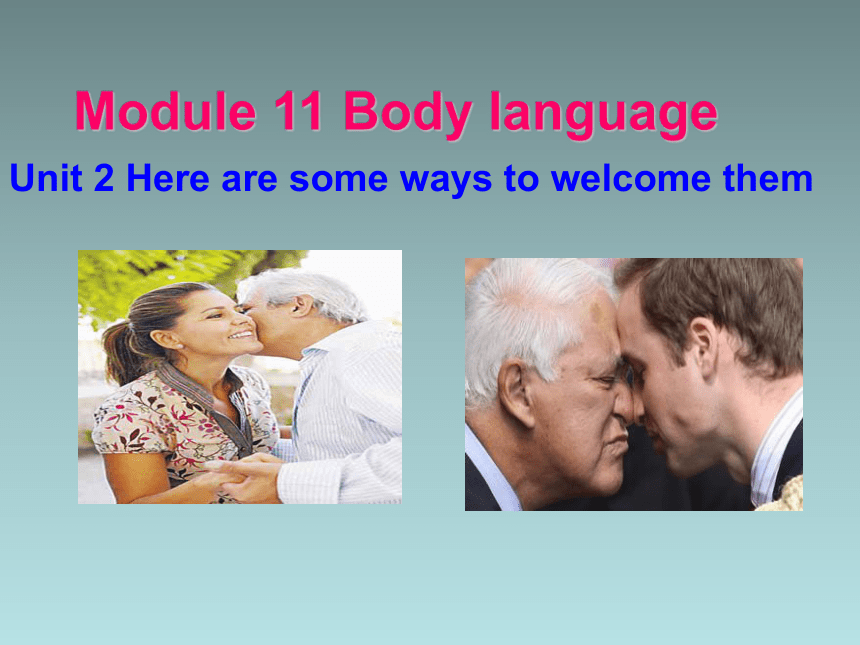 | |
| 格式 | ppt | ||
| 文件大小 | 9.5MB | ||
| 资源类型 | 教案 | ||
| 版本资源 | 外研版 | ||
| 科目 | 英语 | ||
| 更新时间 | 2022-07-10 07:45:13 | ||
图片预览

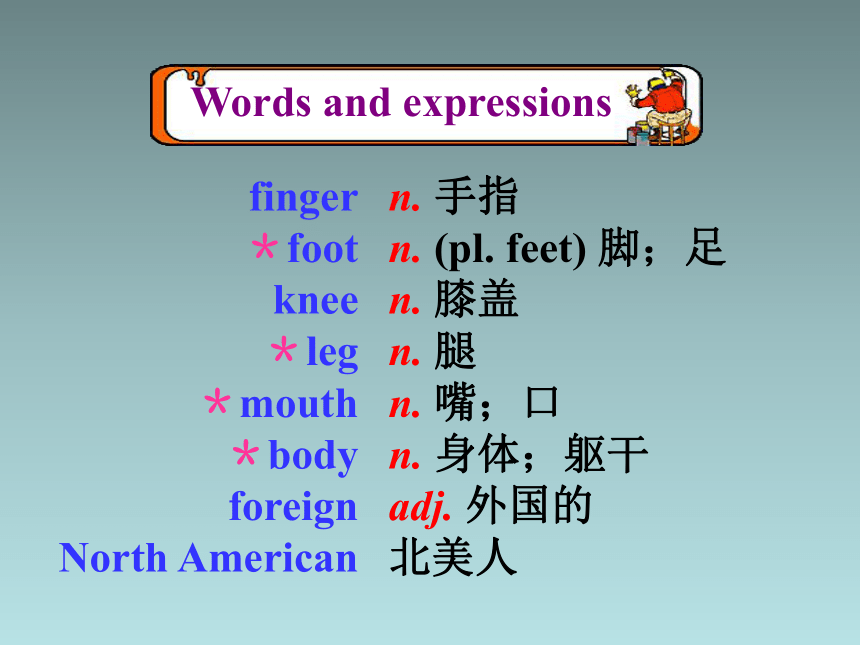
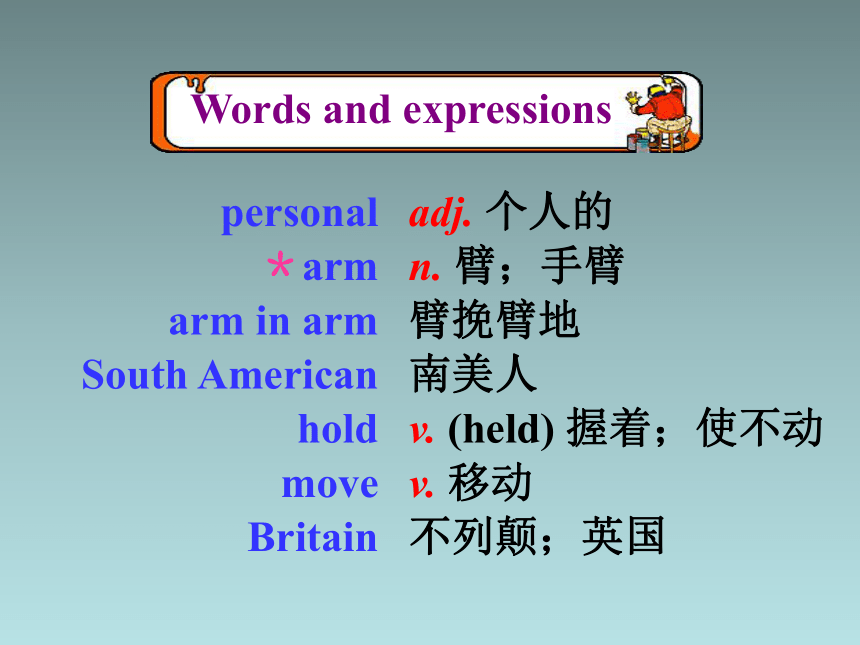
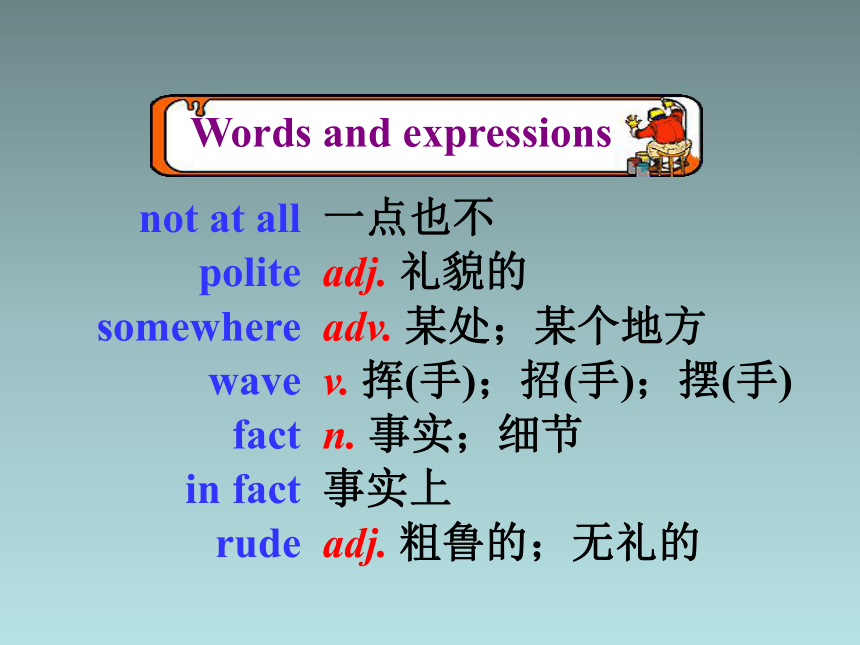
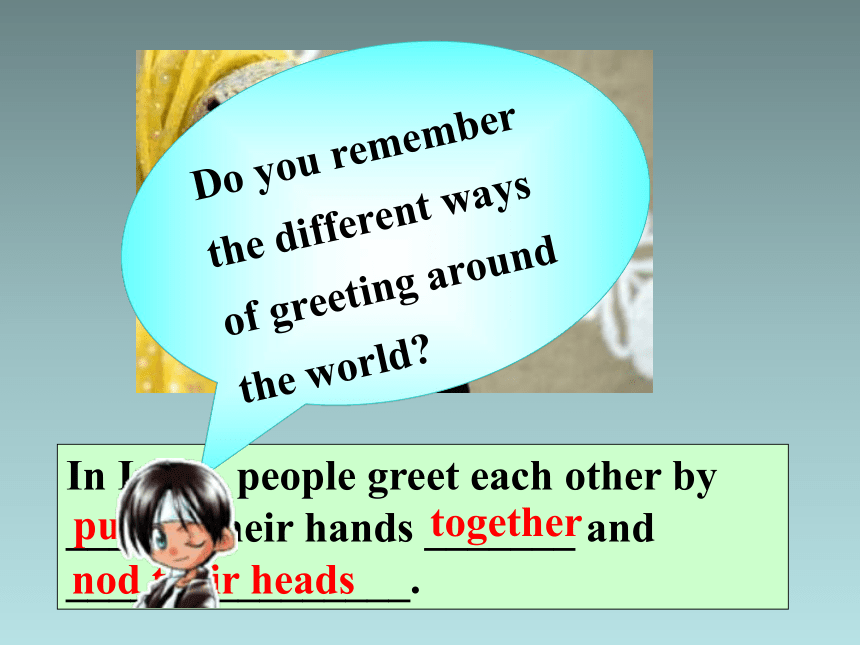
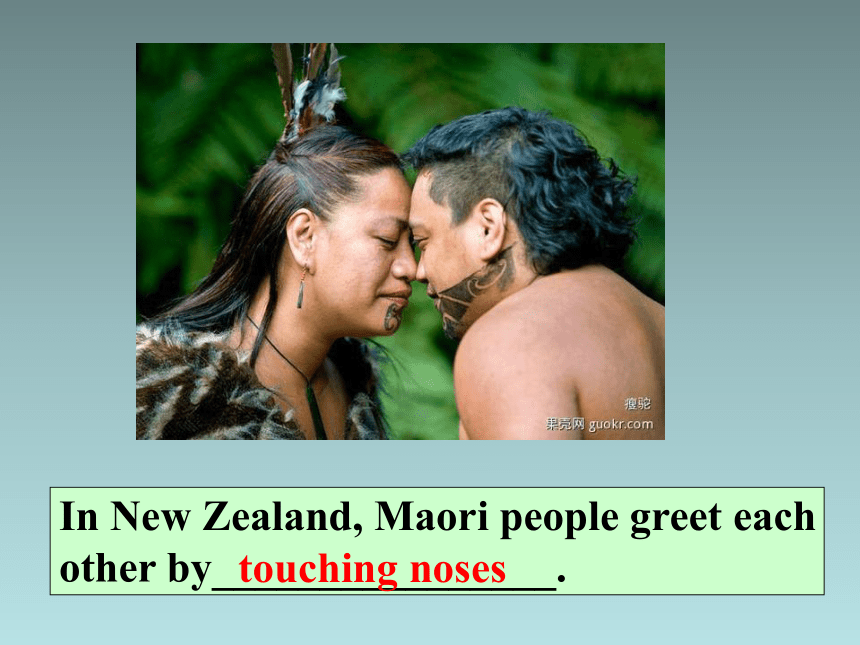
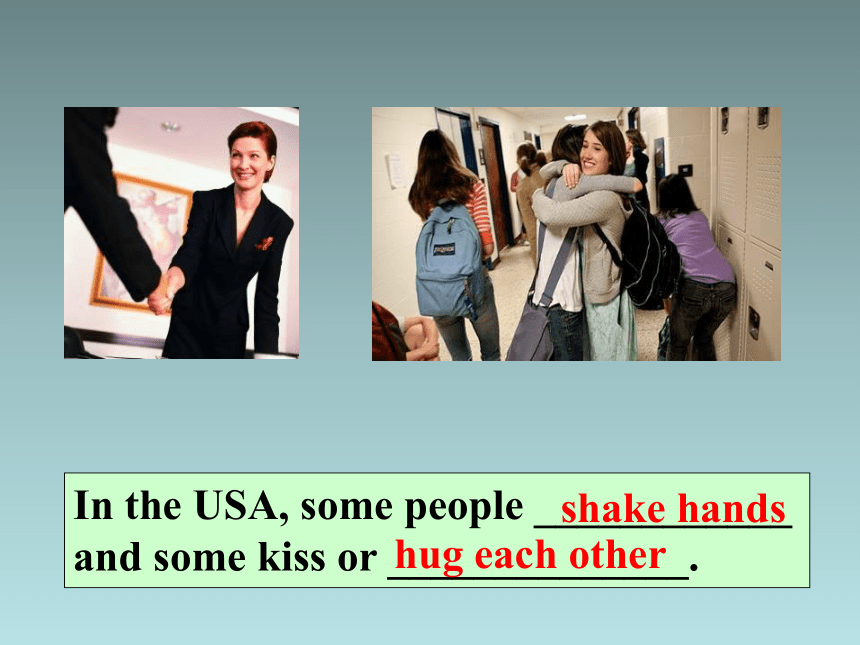
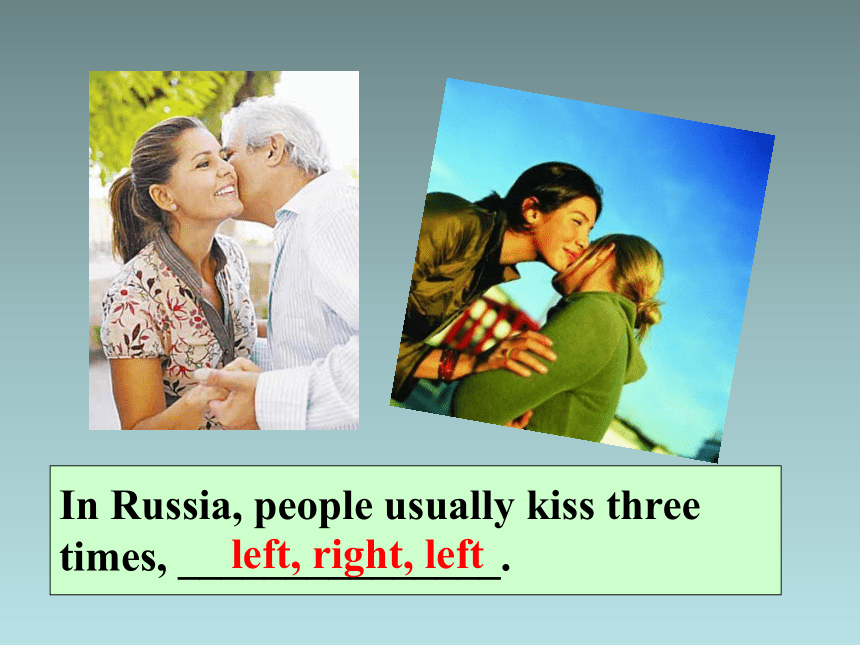
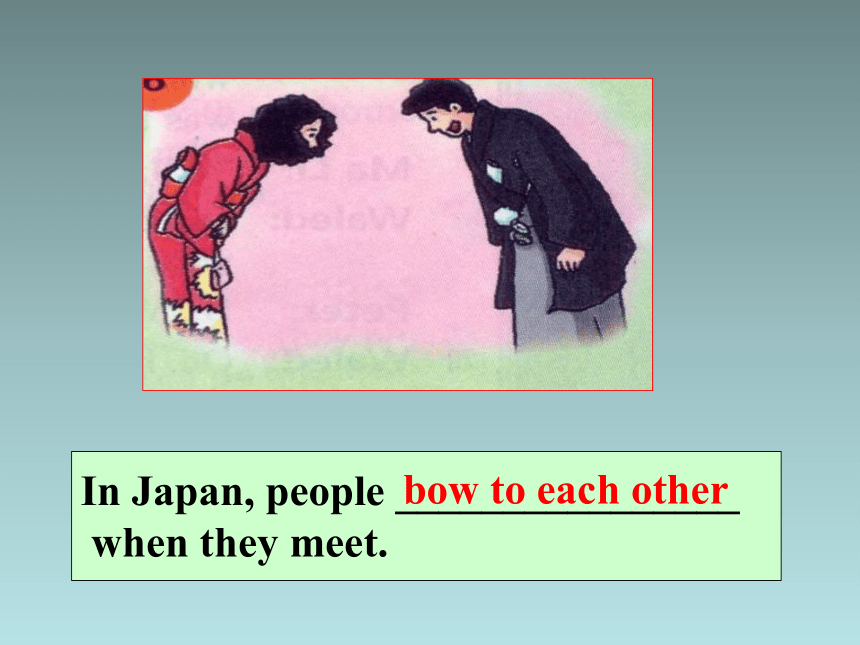
文档简介
(共23张PPT)
Module 11 Body language
Unit 2 Here are some ways to welcome them
finger
*foot
knee
*leg
*mouth
*body
foreign
North American
n. 手指
n. (pl. feet) 脚;足
n. 膝盖
n. 腿
n. 嘴;口
n. 身体;躯干
adj. 外国的
北美人
Words and expressions
personal
*arm
arm in arm
South American
hold
move
Britain
adj. 个人的
n. 臂;手臂
臂挽臂地
南美人
v. (held) 握着;使不动
v. 移动
不列颠;英国
Words and expressions
not at all
polite somewhere
wave
fact
in fact
rude
一点也不
adj. 礼貌的
adv. 某处;某个地方
v. 挥(手);招(手);摆(手)
n. 事实;细节
事实上
adj. 粗鲁的;无礼的
Words and expressions
In India, people greet each other by
______ their hands _______ and
________________.
nod their heads
putting
together
Do you remember the different ways of greeting around the world
In New Zealand, Maori people greet each
other by________________.
touching noses
In the USA, some people ____________
and some kiss or ______________.
shake hands
hug each other
In Russia, people usually kiss three
times, _______________.
left, right, left
In Japan, people ________________
when they meet.
bow to each other
In France, people ___________ in the office every morning.
shake hands
arm
eye
finger
foot
knee
leg
mouth
two feet
hair
ear
nose
[ma θ]
[ni ]
['f g ]
[leg]
[f t]
[ɑ m]
body language
smile
kiss
touch noses
shake hands
wave
to say
goodbye/ hello
walk arm in arm
look at each other
hug each other
[ɑ m]
[we v]
Britain
Middle East
South America
North America
Greece 希腊
North Americans
South Americans
British
中东
南美
北美
希腊
1. What’s the passage mainly about
A. Different countries have different body language
B. We should learn body language.
C. People like using body language when they talk.
2. Where is the passage possibly from
A. A novel
B. A magazine of English
C. A story book
Body language around the world
Tip:Look at the title and some related pictures to choose the best answers. (Predict预测)
Tip: Read the passage quickly, especially the beginning of the passage and the first sentence of each paragraph. (Skim 略读)
1. Match the paragraph with headings.
(A) stand close when talking
(B) ways to welcome foreign students
(C) wave to see goodbye
(D) touch or not touch
(E) look at others when talking
Para 1 ___ Para 2 ___ Para 3 ___ Para 4 ___ Para 5 ___
B
A
D
E
C
2. What the structure of the passage
A. general dividing(总分)
B. dividing general(分总)
1. From this passage(文章), we can know _____.
A. how to travel in other countries
B. how to make friends with foreign students
C. how to welcome foreign students
3. Which picture is right(正确的) for people in the Middle East
A. B.
Our new foreign students are going to arrive very soon, and here are some ways to welcome them.
How close do you stand when you talk to a friend You can stand close to people in the Middle East but don’t stand too close to North Americans! Give them more personal space.
2. Who needs more personal space
A. people in the Middle East B. People in North America
1
2
3
['p snl]
True of false. (T/F)
( ) 1. Not only South Americans but also the British like touching
people.
( )2. It’s always polite for people to look at others.
( ) 3. Americans look at people when they talk.
How about touching people Chinese girls often walk arm in arm with their friends. South Americans sometimes hold your arm when they talk to you, so can’t move away! But in Britain many people don’t like other people to touch them at all.
Do you look at people when you talk In some places, it isn’t polite to look at people when you talk, but in other countries it isn’t polite to look somewhere else. In Britain and the US, people usually look at each other when they talk.
1
2
3
F
F
T
Touching people when talking (para3)
Chinese girls like ______________________
South Americans like ______________________
British Don’t like ________________
A. walking arm in arm
E. holding your arms
B. other people to touch them at all
Looking at people when talking (para4)
In some countries It isn’t polite to ______________
In other countries (Britain, US) Looking somewhere else isn’t _____.
D. look at people
C. polite.
Choose the correct answers to fill in the blanks.
A. walking arm in arm
B. other people to touch them at all
C. polite
D. look at people
E. holding your arms
1. Do people in Greece wave goodbye
2. Guess the meaning of word “rude” in the passage.
A. 有礼貌的 B.无理的,粗鲁的 C.小心的
And how do you say goodbye That’s easy, wave to say goodbye. But be careful! In Greece, it’s not at all polite! In fact, it’s very rude!
No, they don’t.
Tip: Guess general meanings of words from the context(上下文).
1
2
Check the body language you can use in different countries and places.
Stand close Touch each other Look at people when talking
Britain
Middle East
South America
US
√
√
√
√
A: Hello! I’m a reporter from Wenzhou, China. Where are you from
C: I come from Germany.
B: Do people shake hands in your country when they meet visitors
C: Yes, we do. But we don’t like touching others. We don’t hug at the first time.
D: I’m from Brazil, South America.
A: What do people usually do when they talk to others in your country
D: We sometimes hold others arms.
E: I’m from Japan.
B: What do people usually do when they meet visitors
E: We usually take off our hats and bow each other.
B: Do you look at others when you talk
E: Er… we usually don’t look at others eyes when we talk.
A&B: Reporter(记者) C, D, E from different countries.
(India, Russia, Maori, South America, Middle East and Britain… ).
A: Hello! I’m a reporter from ... Where are you from
C: I come from ....
B: Do people … in your country when they meet visitors
C: Yes, we do. (But we don’t ... )
D: I’m from …
A: What do people usually do when they talk to others in your country
D: We ....
E: I’m from Japan.
B: What do people usually do when they meet visitors
E: We ….
B: Do you look at others when you talk
E: We … / We don’t ….
Germany Shake hands when they meet visitors.
Don’t like touching.
Brazil …
...
Japan Bow when they meet visitors.
Don’t look at others when they talk.
Report:
Bow when you meet people from Japan.
Don’t look at their eyes when you talk with Japanese.
… when you ….
Don’t …. when you…
Homework
Finish Workbook One.
Read the passage at least four times.
Remember the new words and expression.
Underline some useful phrases which you think are important.
Module 11 Body language
Unit 2 Here are some ways to welcome them
finger
*foot
knee
*leg
*mouth
*body
foreign
North American
n. 手指
n. (pl. feet) 脚;足
n. 膝盖
n. 腿
n. 嘴;口
n. 身体;躯干
adj. 外国的
北美人
Words and expressions
personal
*arm
arm in arm
South American
hold
move
Britain
adj. 个人的
n. 臂;手臂
臂挽臂地
南美人
v. (held) 握着;使不动
v. 移动
不列颠;英国
Words and expressions
not at all
polite somewhere
wave
fact
in fact
rude
一点也不
adj. 礼貌的
adv. 某处;某个地方
v. 挥(手);招(手);摆(手)
n. 事实;细节
事实上
adj. 粗鲁的;无礼的
Words and expressions
In India, people greet each other by
______ their hands _______ and
________________.
nod their heads
putting
together
Do you remember the different ways of greeting around the world
In New Zealand, Maori people greet each
other by________________.
touching noses
In the USA, some people ____________
and some kiss or ______________.
shake hands
hug each other
In Russia, people usually kiss three
times, _______________.
left, right, left
In Japan, people ________________
when they meet.
bow to each other
In France, people ___________ in the office every morning.
shake hands
arm
eye
finger
foot
knee
leg
mouth
two feet
hair
ear
nose
[ma θ]
[ni ]
['f g ]
[leg]
[f t]
[ɑ m]
body language
smile
kiss
touch noses
shake hands
wave
to say
goodbye/ hello
walk arm in arm
look at each other
hug each other
[ɑ m]
[we v]
Britain
Middle East
South America
North America
Greece 希腊
North Americans
South Americans
British
中东
南美
北美
希腊
1. What’s the passage mainly about
A. Different countries have different body language
B. We should learn body language.
C. People like using body language when they talk.
2. Where is the passage possibly from
A. A novel
B. A magazine of English
C. A story book
Body language around the world
Tip:Look at the title and some related pictures to choose the best answers. (Predict预测)
Tip: Read the passage quickly, especially the beginning of the passage and the first sentence of each paragraph. (Skim 略读)
1. Match the paragraph with headings.
(A) stand close when talking
(B) ways to welcome foreign students
(C) wave to see goodbye
(D) touch or not touch
(E) look at others when talking
Para 1 ___ Para 2 ___ Para 3 ___ Para 4 ___ Para 5 ___
B
A
D
E
C
2. What the structure of the passage
A. general dividing(总分)
B. dividing general(分总)
1. From this passage(文章), we can know _____.
A. how to travel in other countries
B. how to make friends with foreign students
C. how to welcome foreign students
3. Which picture is right(正确的) for people in the Middle East
A. B.
Our new foreign students are going to arrive very soon, and here are some ways to welcome them.
How close do you stand when you talk to a friend You can stand close to people in the Middle East but don’t stand too close to North Americans! Give them more personal space.
2. Who needs more personal space
A. people in the Middle East B. People in North America
1
2
3
['p snl]
True of false. (T/F)
( ) 1. Not only South Americans but also the British like touching
people.
( )2. It’s always polite for people to look at others.
( ) 3. Americans look at people when they talk.
How about touching people Chinese girls often walk arm in arm with their friends. South Americans sometimes hold your arm when they talk to you, so can’t move away! But in Britain many people don’t like other people to touch them at all.
Do you look at people when you talk In some places, it isn’t polite to look at people when you talk, but in other countries it isn’t polite to look somewhere else. In Britain and the US, people usually look at each other when they talk.
1
2
3
F
F
T
Touching people when talking (para3)
Chinese girls like ______________________
South Americans like ______________________
British Don’t like ________________
A. walking arm in arm
E. holding your arms
B. other people to touch them at all
Looking at people when talking (para4)
In some countries It isn’t polite to ______________
In other countries (Britain, US) Looking somewhere else isn’t _____.
D. look at people
C. polite.
Choose the correct answers to fill in the blanks.
A. walking arm in arm
B. other people to touch them at all
C. polite
D. look at people
E. holding your arms
1. Do people in Greece wave goodbye
2. Guess the meaning of word “rude” in the passage.
A. 有礼貌的 B.无理的,粗鲁的 C.小心的
And how do you say goodbye That’s easy, wave to say goodbye. But be careful! In Greece, it’s not at all polite! In fact, it’s very rude!
No, they don’t.
Tip: Guess general meanings of words from the context(上下文).
1
2
Check the body language you can use in different countries and places.
Stand close Touch each other Look at people when talking
Britain
Middle East
South America
US
√
√
√
√
A: Hello! I’m a reporter from Wenzhou, China. Where are you from
C: I come from Germany.
B: Do people shake hands in your country when they meet visitors
C: Yes, we do. But we don’t like touching others. We don’t hug at the first time.
D: I’m from Brazil, South America.
A: What do people usually do when they talk to others in your country
D: We sometimes hold others arms.
E: I’m from Japan.
B: What do people usually do when they meet visitors
E: We usually take off our hats and bow each other.
B: Do you look at others when you talk
E: Er… we usually don’t look at others eyes when we talk.
A&B: Reporter(记者) C, D, E from different countries.
(India, Russia, Maori, South America, Middle East and Britain… ).
A: Hello! I’m a reporter from ... Where are you from
C: I come from ....
B: Do people … in your country when they meet visitors
C: Yes, we do. (But we don’t ... )
D: I’m from …
A: What do people usually do when they talk to others in your country
D: We ....
E: I’m from Japan.
B: What do people usually do when they meet visitors
E: We ….
B: Do you look at others when you talk
E: We … / We don’t ….
Germany Shake hands when they meet visitors.
Don’t like touching.
Brazil …
...
Japan Bow when they meet visitors.
Don’t look at others when they talk.
Report:
Bow when you meet people from Japan.
Don’t look at their eyes when you talk with Japanese.
… when you ….
Don’t …. when you…
Homework
Finish Workbook One.
Read the passage at least four times.
Remember the new words and expression.
Underline some useful phrases which you think are important.
同课章节目录
- Module 1 Lost and found
- Unit 1 Whose bag is this?
- Unit 2 Are they yours?
- Unit 3 Language in use
- Module 2 What can you do ?
- Unit 1 I can play the piano
- Unit 2 I can run really fast
- Unit 3 Language in use
- Module 3 Making plans
- Unit 1 What are you going to do at the weekends?
- Unit 2 We're going to cheer the players.
- Unit 3 Language in use
- Module 4 Life in the future
- Unit 1 Everyone will study at home
- Unit 2 Every family will have a small plane.
- Unit 3 Language in use
- Module 5 Shopping
- Unit 1 What can I do for you?
- Unit 2 You can buy everything on the Internet
- Unit 3 Language in use
- Module 6 Around town
- Unit 1 Could you tell me how to get to the Nationa
- Unit 2 The London Eye is on your right.
- Unit 3 Language in use
- Revision module A
- Module 7 My past life
- Unit 1 I was born in a small village.
- Unit 2 I was born in Quincy.
- Unit 3 Language in use
- Module 8 Story time
- Unit 1 Once upon a time….
- Unit 2 Goldilocks hurried out of the house.
- Unit 3 Language in use
- Module 9 Life history
- Unit 1 He left school and began work at the age of
- Unit 2 He decided to be an actor.
- Unit 3 Language in use
- Module 10 A holiday journey
- Unit 1 What did you do?
- Unit 2 This morning we took a walk.
- Unit 3 Language in use
- Module 11 Body language
- Unit 1 They touch noses!
- Unit 2 Here are some ways to welcome them.
- Unit 3 Language in use
- Module 12 Western music
- Unit 1 It's so beautiful!
- Unit 2 Vienna is the centre of European classical
- Unit 3 Language in use
- Revision module B
